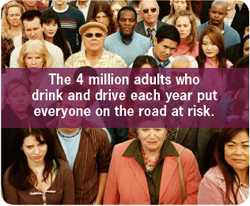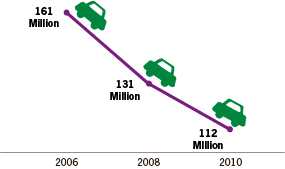Drinking and Driving
A Threat to Everyone
On This Page
October 2011


 112M
112M
Adults reported drinking and driving about 112 million times in 2010.
 85%
85%
85% of drinking and driving episodes were reported by binge drinkers.
 4 in 5
4 in 5
Four in 5 people who drink and drive are men.
US adults drank too much and got behind the wheel about 112 million times in 2010. Though episodes of driving after drinking too much ("drinking and driving") have gone down by 30% during the past 5 years, it remains a serious problem in the US. Alcohol-impaired drivers* are involved in about 1 in 3 crash deaths, resulting in nearly 11,000 deaths in 2009.
Driving drunk is never OK. Choose not to drink and drive and help others do the same.
*These drivers had blood alcohol concentrations of at least 0.08%. This is the illegal blood alcohol concentration level for adult drivers in the United States.
Problem
Your best defense against a drunk driver is to buckle up every time.
- Every person in every seat should be buckled up on every trip. Seat belts reduce serious injuries and deaths from crashes by about 50%.
- Primary enforcement seat belt laws allow police to stop vehicles just because someone is not wearing a seat belt. These state laws are effective in increasing seat belt use.
People who drink and drive put everyone on the road in danger
Certain groups are more likely to drink and drive than others.
- Men were responsible for 4 in 5 episodes (81%) of drinking and driving in 2010.
- Young men ages 21-34 made up only 11% of the U.S. adult population in 2010, yet were responsible for 32% of all instances of drinking and driving.
- 85% of drinking and driving episodes were reported by people who also reported binge drinking. Binge drinking means 5 or more drinks for men or 4 or more drinks for women during a short period of time.
There are proven ways to prevent people from drinking and driving.
- At sobriety checkpoints, police stop drivers to judge if they are driving under the influence of alcohol. More widespread, frequent use of these checkpoints could save about 1,500 to 3,000 lives on the road each year.
- Minimum legal drinking age laws prohibit selling alcohol to people under age 21 in all 50 states and the District of Columbia. Keeping and enforcing 21 as the minimum legal drinking age helps keep young, inexperienced drivers from drinking and driving.
- Ignition interlocks prevent drivers who were convicted of alcohol-impaired driving from operating their vehicles if they have been drinking. Interlocks are effective in reducing re-arrest rates from drinking and driving by about two-thirds while the device is on the vehicle.

SOURCE: CDC Behavioral Risk Factor Surveillance System, US 2010
Drinking and driving episodes by gender and age, 2010

SOURCE: CDC Behavioral Risk Factor Surveillance System, US 2010
Some likely effects on driving

Adapted from The ABCs of BAC, National Highway Traffic Safety Administration, 2005, and How to Control Your Drinking, WR Miller and RF Munoz, University of New Mexico, 1982.
Self-reported annual drinking and driving episodes

SOURCE: CDC Behavioral Risk Factor Surveillance System, US 2006, 2008 and 2010
What Can Be Done
States can
- Enforce 0.08% blood alcohol concentration and minimum legal drinking age laws.
- Expand the use of sobriety checkpoints.
- Require ignition interlocks for everyone convicted of drinking and driving, starting with their first offense.
- Consider including strategies to reduce binge drinking—such as increasing alcohol taxes—to reduce drinking and driving, since the two behaviors are linked.
- Pass primary enforcement seat belt laws that cover everyone in the car.
Employers can
- Set policies that immediately take away all work-related driving privileges for any employee cited for drinking and driving while using a company or personal vehicle for work purposes.
- Use workplace health promotion programs to communicate the dangers of drinking and driving, including information directed to family members.
Health professionals can
- Help patients realize that car crashes are the leading cause of death for everyone ages 5-34 and that 1 in 3 crash deaths involves a drunk driver.
- Routinely screen patients for risky drinking patterns, including binge drinking, and provide a brief intervention—a 10–15 minute counseling session—for patients who screen positive.
Everyone can
- Choose not to drink and drive and help others do the same.
- Before drinking, designate a nondrinking driver when with a group.
- If out drinking, get a ride home or call a taxi.
- Don't let friends drink and drive.
- Choose not to binge drink themselves and help others not to do it.
- Talk with a doctor or nurse about drinking and driving and request counseling if drinking is causing health, work, or social problems.
- Buckle up every time, no matter how short the trip. Encourage passengers in the car to buckle up, including those in the back seat.
Science Behind the Issue
Related Pages
- Vital Signs Issue details: Alcohol-Impaired Driving Among Adults — United States, 2010. Morbidity and Mortality Weekly Report (MMWR)
- CDC Feature- Drinking and Driving: A Threat to Everyone
- Drinking and Driving – What You Need to Know [PODCAST – 1:15 minutes]
- Drinking and Driving – What You Need to Know [PSA – 0:60 seconds]
- Winnable Battles
- Policy Impact: Impaired Driving
- Impaired Driving
- Motor Vehicle Safety
- Vital Signs: Binge Drinking
- Vital Signs: Adult Seatbelt Use
On Other Web Sites
- Page last reviewed: October 3, 2011
- Page last updated: October 15, 2013
- Content source:
- National Center for Injury Prevention and Control, Division of Unintentional Injury Prevention
- Page maintained by: Office of the Associate Director for Communications (OADC)


 ShareCompartir
ShareCompartir